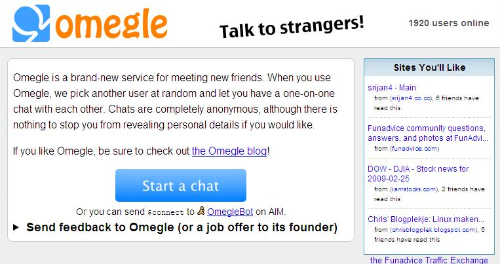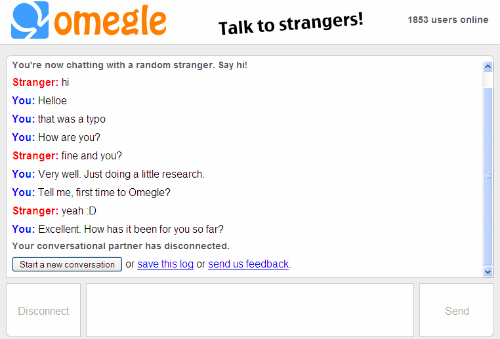The New York Times recently highlighted new chat site Omegle.com in their Technology section. It’s a site we’ve been watching since it first hit the scene in March 2009. Their premise is simple: Click “Start a chat” and you’re immediately connected with a completely random person.
No logins. No terms & conditions. No warnings. Just sink or swim. The living embodiment of Mama Gump’s take on life: It’s a box of chocolates and you don’t know what you’re gonna get.
In the month or so I’ve been using Omegle I’ve spoken to an unlucky-in-love teenager in Ohio, been invited to couchsurf at an apartment in Bergen, Norway, been the guest on a “talk show” hosted by “Oprah Ricardo”, and had a variety of chats that have lasted from ten seconds to half an hour.
And I just can’t stop. Maybe it’s the thrill of the unknown, but I’m hooked, and I’m not alone. Here are a few recent Twitter remarks about Omegle:
anc__: omegle.com is the strangest site i’ve ever been to…….ever…….
Addie_Lou: CANNOT STOP OMEGLE
jaywinsthegame: god, omegle is so much effing fun.
googlygoogly: talking to some girl on omegle from north korea? is that even possible?
skankage: FUN as HELL! RT @tonylittle Oh god. Omegle.com is fantastic. You can talk to random people anonymously and make a damn fool of yourself.
Being so young, the the site’s normal stats don’t show us a lot, but there’s still evidence that Omegle is touching a nerve in significant ways (all counts are as of May 11, 2009):
- Post to Omegle.com founder Leif K-Brooks’s March 30 official Omegle blog has received 381 comments
- Mention of Omegle on XKCD’s Blag [sic] has received 592 comments, mostly reposts of actual Omegle conversations.
- Gawker post has 34,552 views.
It was enough press to make me take notice. There is enough promise to Omegle’s “Talk to a stranger” proposition to suggest that Omegle can become a relevant and profitable web property. But it will need to take a slow, methodical approach in growth and never deviate from the core promise of the site: At any moment, you can chat with a random stranger. This core value should never be compromised at the expense of further channel development.
What’s old is new again
Omegle is scoring big points and drawing modest crowds via organic growth. Positive mentions on trusted media are the primary drivers of traffic on the mainstream web. Visits are being driven by a curiosity factor – curiosity in a technology that is not much more than AOL’s People Connection circa 1994 (for you kids, that’s AIM before AIM was AIM, and you had to use a phone line). Instead of touting some newfangled communication platform here (such as, say, microblogging), Omegle has stripped away the technology and laid the web prostrate before us in its most raw form and in a refreshing way.
Your friends aren’t really your friends
Omegle’s continued growth will come from building a community of enthusiastic users touting the medium, like any successful social media site. We’ve come so far with social networking and media sites that Omegle’s retro charm is very inviting. I rarely use the chat feature of Facebook because the not-so-sad reality is that many of my “friends” aren’t really my friends anymore or never were; and this does not reflect poorly on them, or me, at all. Growth, time, and geography spin us apart. Omegle has touched upon an urgent need for the Web Generation to meet new people and be themselves in a pseudo-social way.
Omegle will see its greatest growth through word of mouth, predominantly on message boards and social media. Fortunately again, Omegle has emerged and entered its experimentation phase at a time when social networks are at a penetration peak. It could be a fairly quick experimentation phase for Omegle.com if its early adopters tout the channel. However, the hard work lies ahead when it enters what promises to be a long gestation and a struggle for adoption with a platform that is hardly new.
Encouraging adoption
Omegle’s initial charm will, rather ironically, lead to its stagnation as many users hit a “What Now” moment earlier than for most other social media. Answering that question and making some necessary changes to the channel will help encourage Omegle growth. Changes should include community moderation and user ratings of good conversations. I’ll expand on these ideas in a future post. Until then, I’d keep an eye on the growth of Omegle.
Takeaway Message
I recommend trying Omegle. I think there’s potential here for viral marketing opportunities. Explore giving away a product to a willing participant. Invite them to contact you after the chat and send them your product with the understanding that they’ll give you some feedback. See what happens. Omegle is clearly something you shouldn’t spend a lot of time on, but it’s worth experimenting. Creating great content on a platform that encourages one-to-one communication is hard to justify from an ROI perspective, but you never know.
My Question to You
What do you think of Omegle? Any ideas on how you can create compelling content for an individual that entices them to share their experience with your brand or your product? Let me know if you have any early successes!


